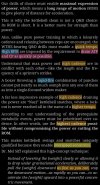Georgiaoutdoors
Level 5 Valued Member
As I continue to dive into the StrongFirst literature I revise my thoughts on training ideas. As a locomotive endurance athlete (trail running, OCR, backpacking) I really like the idea of Q&D sprint protocols: a) brief (10 second?) sprint every 3 minutes, b) Sprint and pushup protocol from a newsletter I believe.
I think both could be good regular additions to my GPP training when not preparing for a specific event. I could definitely envision some cycles with these, LISS days, and some pull-ups. That being said, I experience some limitations that make doing sprints impractical sometimes, happy to reply with further details if requested.
Here are some thoughts/questions I am pondering:
-is using a treadmill a viable alternative? I have experimented with it and enjoy it, but I understand you miss out on the acceleration component
-What about running in place with something like egg weights maybe and pushups as an alternative?
-What about mixing Q&D movements, i.e. 2x/week sprint and pushups, 2x/week swings and pushups, rest of the week LISS?
-What would we consider the minimum effective dose of Q&D, especially sprint protocol, to derive benefit?
-Anyone experienced with mixing some Q&D, easy strength, and LISS all in the same week for a cycle? if so, how did it go?
I think both could be good regular additions to my GPP training when not preparing for a specific event. I could definitely envision some cycles with these, LISS days, and some pull-ups. That being said, I experience some limitations that make doing sprints impractical sometimes, happy to reply with further details if requested.
Here are some thoughts/questions I am pondering:
-is using a treadmill a viable alternative? I have experimented with it and enjoy it, but I understand you miss out on the acceleration component
-What about running in place with something like egg weights maybe and pushups as an alternative?
-What about mixing Q&D movements, i.e. 2x/week sprint and pushups, 2x/week swings and pushups, rest of the week LISS?
-What would we consider the minimum effective dose of Q&D, especially sprint protocol, to derive benefit?
-Anyone experienced with mixing some Q&D, easy strength, and LISS all in the same week for a cycle? if so, how did it go?

